Table of Contents
Pakistan’s culinary landscape is a vibrant tapestry of flavors, aromas, and traditions that tell a rich story of cultural heritage and gastronomic excellence. From the bustling street food markets of Lahore to the sophisticated kitchens of Karachi, Pakistan famous foods represent a delectable journey through centuries of culinary craftsmanship.
Traditional Pakistani dishes blend aromatic spices, time-honored cooking techniques, and regional influences that create an unparalleled dining experience. Whether you’re craving the sizzling street food in Pakistan or seeking authentic home-cooked meals, the country’s cuisine offers a mouth-watering exploration of taste and tradition that captivates food lovers from around the world.
Understanding the Rich Culinary Heritage of Pakistan
The culinary heritage of Pakistan is a fascinating blend of historical influences, regional diversity, and centuries-old cooking traditions that make famous food in Pakistan truly extraordinary. From the Mughal era’s royal kitchens to the local street food vendors, famous Pakistan food reflects a complex tapestry of cultural interactions, geographical diversity, and agricultural abundance.
The cuisine draws inspiration from various historical periods, including Persian, Central Asian, and South Asian culinary traditions, creating a unique gastronomic identity that goes beyond mere sustenance. Each region of Pakistan contributes its distinct flavors, ingredients, and cooking techniques, resulting in a rich and diverse culinary landscape that represents the country’s cultural complexity and historical depth.
Regional Diversity in Food Traditions
Pakistan’s regional food diversity showcases the country’s remarkable culinary mosaic, where traditional foods in Pakistan vary dramatically from one province to another.
In Punjab, the cuisine is known for its rich, buttery flavors and tandoor-cooked specialties, while Sindhi cuisine embraces the bounty of fresh seafood and unique spice combinations. The mountainous regions of Gilgit-Baltistan offer hearty dishes that reflect the area’s cold climate, featuring dried fruits and yak meat preparations.
Meanwhile, Balochistan’s traditional cooking methods emphasize slow-cooked meats and sajji-style preparations, and Khyber Pakhtunkhwa’s cuisine is characterized by its distinctive use of meat, long-grain rice, and robust spices. This incredible regional diversity ensures that exploring Pakistani cuisine is an endless adventure of discovering unique flavors and cooking methods.
Top 5 Most Famous Pakistani Foods
Biryani: The Crown Jewel of Pakistani Cuisine
Biryani, the undisputed crown jewel of Pakistani cuisine, is an aromatic rice dish that has earned its place as one of the most celebrated culinary creations in South Asian gastronomy. This fragrant masterpiece consists of long-grain basmati rice layered with tender meat or vegetables, infused with a signature blend of spices including cardamom, saffron, cinnamon, and bay leaves, all cooked together in a slow-cooking process known as ‘dum’.
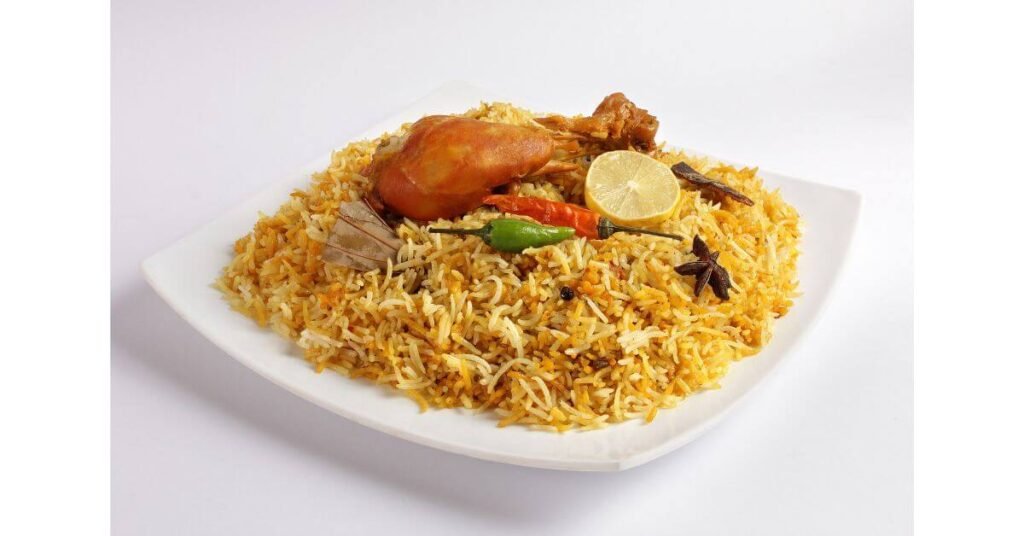
At Passage to Pakistan, we guide our food enthusiasts to the most renowned biryani destinations across the country. In Karachi, we’ll take you to Burns Road and Saddar, where the legendary Student Biryani and Zahid Nihari serve their distinctive Sindhi-style biryani.
In Lahore, we’ll explore the bustling streets of Gawalmandi, where the Punjabi-style biryani offers a unique local twist. For an authentic Memoni biryani experience, we’ll visit the historic neighborhoods of Karachi where traditional Memoni families have been perfecting their recipes for generations.
Each region adds its unique touch – Karachi’s biryani is known for its spicy kick and potatoes, while Lahore’s version is milder and more aromatic. Our culinary tours ensure you taste these regional variations, learn about their preparation techniques, and understand why this dish holds such cultural significance in Pakistani cuisine.
Regional Biryani Variations and Traditional Cooking Methods
The art of biryani preparation varies significantly across Pakistan’s diverse regions, each boasting its own signature style and cooking techniques. In Karachi, the iconic Sindhi biryani stands out with its fiery spice blend, tender potato chunks, and distinctive yellow-orange hue derived from saffron and food coloring. The Lahori biryani embraces a more subtle approach, focusing on the aromatic elements of whole spices like star anise, cardamom, and cinnamon bark.
The Peshawari version features succulent pieces of lamb or mutton, while Memoni biryani is renowned for its complex layering technique and secret spice combinations passed down through generations. The cooking process universally follows the ‘dum’ method, where the rice and meat are layered in a heavy-bottomed pot sealed with dough to trap the steam, allowing the flavors to meld perfectly.
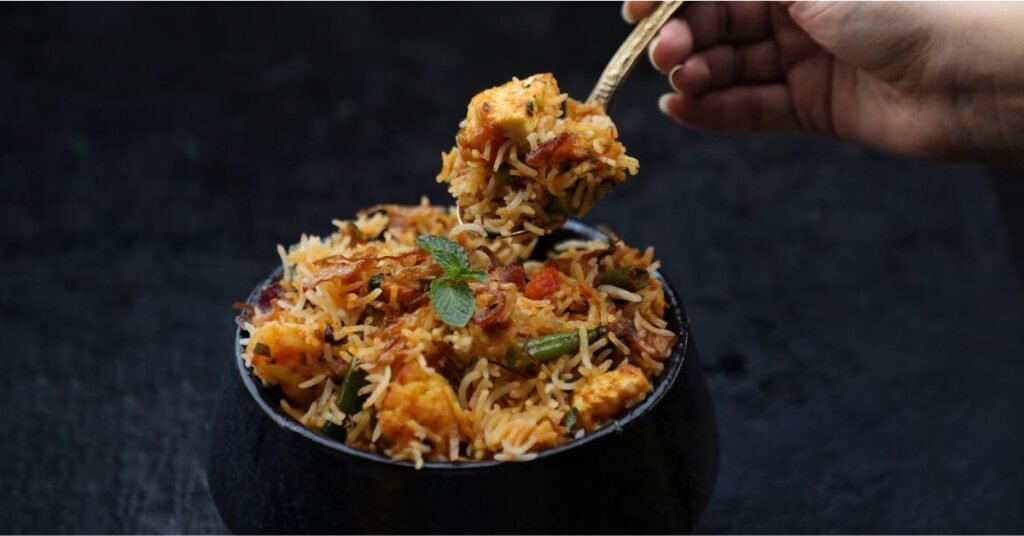
Essential ingredients include premium long-grain basmati rice, meat (typically chicken, mutton, or beef), yogurt for marination, ghee for richness, and a carefully balanced mixture of whole and ground spices including garam masala, saffron, and kewra water for the signature aroma.
Karahi: A Spicy and Flavorful – Delight Pakistan Famous Food
Karahi, a sizzling testament to Pakistan’s love affair with robust flavors, is a dish that takes its name from the deep, wok-like vessel in which it’s prepared. This iconic Pakistani dish features tender pieces of meat (typically chicken or mutton) cooked with fresh tomatoes, ginger, garlic, and green chilies, creating a thick, spicy gravy that’s finished with a generous sprinkle of fresh coriander and julienned ginger.
At Passage to Pakistan, we guide our culinary adventurers to the most celebrated Karahi destinations across the country. In Peshawar’s historic Namak Mandi, we’ll introduce you to the famous Charsi Tikka and Karahi, where the smoky aroma of cooking meat fills the air and traditional recipes remain unchanged for generations. In Lahore’s Food Street and Burns Road in Karachi, we’ll take you to legendary establishments like Butt Karahi and Waheed Kabab House, where the sizzling sound of karahi being prepared becomes a symphony for food lovers.
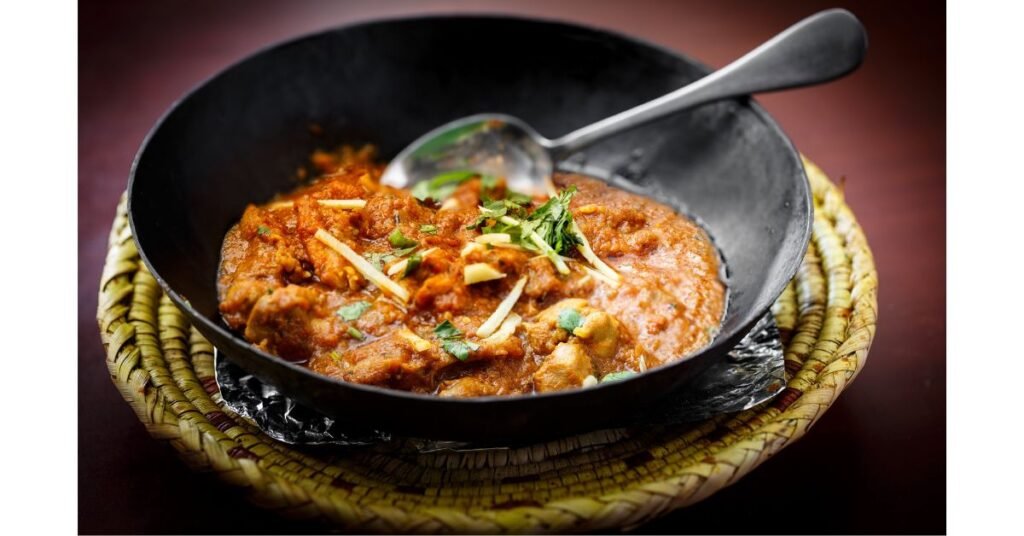
Each region offers its unique interpretation – Peshawar’s version is known for its minimalist approach using only salt and meat’s natural flavors, while Lahore’s style incorporates more tomatoes and spices. Salt’n Pepper Village and Andaaz Restaurant are must-visit destinations for those seeking a more upscale karahi dining experience. Our tours ensure you not only taste these regional specialties but also witness the theatrical preparation process, where skilled chefs toss and turn the ingredients in massive karahis over roaring flames.
Pro Tip: For the most authentic experience, we recommend trying the ‘Kadai Ghost’ (mutton karahi) in Peshawar and the ‘White Karahi’ in Lahore’s Lakshmi Chowk area, where the dish is cooked in butter instead of oil for a uniquely rich flavor.
Traditional Karahi Preparations: Chicken and Mutton Specialties
Chicken karahi, a quick-cooking favorite among locals and tourists alike, showcases the perfect balance of tender meat and aromatic spices. The preparation begins with fresh chicken pieces cooked in their own juices, combined with ripe tomatoes, green chilies, and a generous amount of ginger.
The dish is cooked on high heat in a circular wok-like vessel, allowing the tomatoes to break down into a thick, clingy sauce that coats each piece of meat perfectly. The finishing touch includes a garnish of fresh coriander, julienned ginger, and a dollop of butter, creating a glossy, flavorful dish that’s best enjoyed with freshly baked naan.
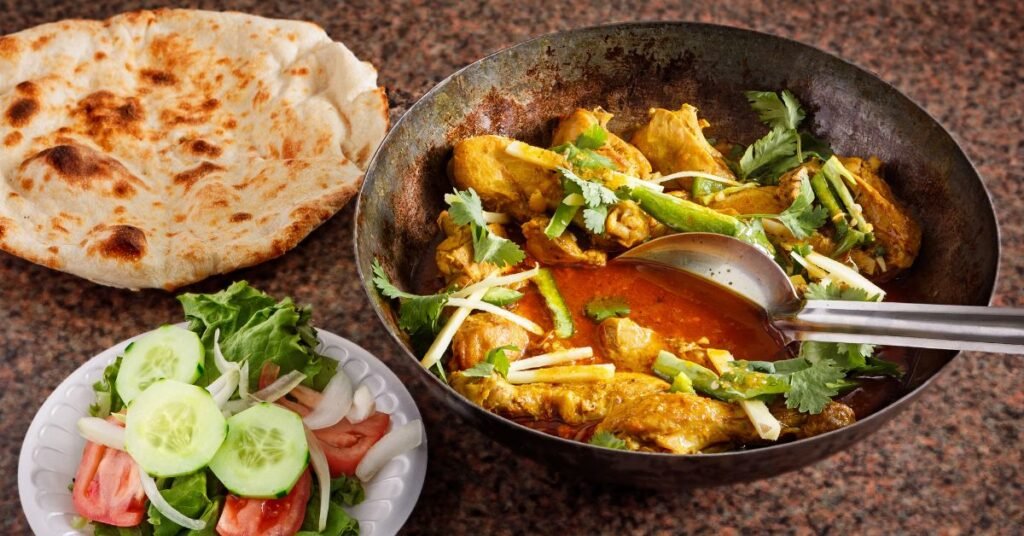
Mutton karahi, considered the more premium variant, requires a longer cooking time to achieve its signature tenderness and depth of flavor. The preparation method remains similar, but the meat is often cooked on a slower flame to ensure it becomes perfectly tender while absorbing all the rich spices. Many renowned establishments across Pakistan marinate the mutton beforehand in a special blend of yogurt and spices, which helps tenderize the meat and infuse it with extra flavor.
The result is a richly satisfying dish where the robust flavors of the meat shine through the spicy, tomato-based gravy, making it a must-try delicacy for serious food enthusiasts.
Nihari: The Royal Breakfast Dish
Nihari, the regal morning feast that traces its roots to the Mughal kitchens, stands as one of Pakistan’s most revered breakfast traditions. This rich, slow-cooked stew features tender meat (traditionally beef shank) simmered overnight in a complex blend of spices, creating a thick, gelatinous gravy that’s garnished with fresh ginger, green chilies, and a generous squeeze of lemon.
Shahi nihari, as it’s often called, was historically served to the nobility, but today it has become a beloved dish enjoyed across all social classes, particularly during winter months when its warming properties are most appreciated.

At Passage to Pakistan, we guide our guests to the most authentic nihari establishments, where generations-old recipes are still followed with unwavering dedication. In Lahore, we’ll take you to the iconic Waris Nihari in the heart of the old city, where the rich aroma of simmering spices fills the narrow streets before dawn. In Karachi, the legendary Javed Nihari and Waheed Nihari serve their signature versions, each claiming to hold the secret to the perfect spice blend.
The experience of enjoying nihari is incomplete without the traditional accompaniments – fresh naan bread, crispy maghaz (brain), nalli (bone marrow), and a side of raw onions and fresh coriander. Our culinary tours are timed to ensure you experience this dish in its most authentic setting – early morning, when the first batch of the day is served piping hot to eager customers who have been waiting since dawn.
The Royal Legacy and Famous Establishments of Pakistani Nihari
The regal history of shahi nihari weaves seamlessly into Pakistan’s modern culinary identity, transforming from its Mughal origins in Old Delhi’s royal kitchens to becoming a cherished national dish. The word ‘nihar,’ derived from the Arabic ‘nahar’ meaning ‘day,’ reflects its traditional consumption at daybreak – a tradition that continues in Pakistan’s most celebrated nihari establishments.
Today, legendary venues like Karachi’s Zahid Nihari and Javed Nihari, along with Lahore’s iconic Waris Nihari, maintain the authentic preparation methods where the dish simmers overnight in a secret blend of spices. These establishments, some dating back to the 1960s, have become cultural institutions where the craft of nihari-making is passed down through generations.
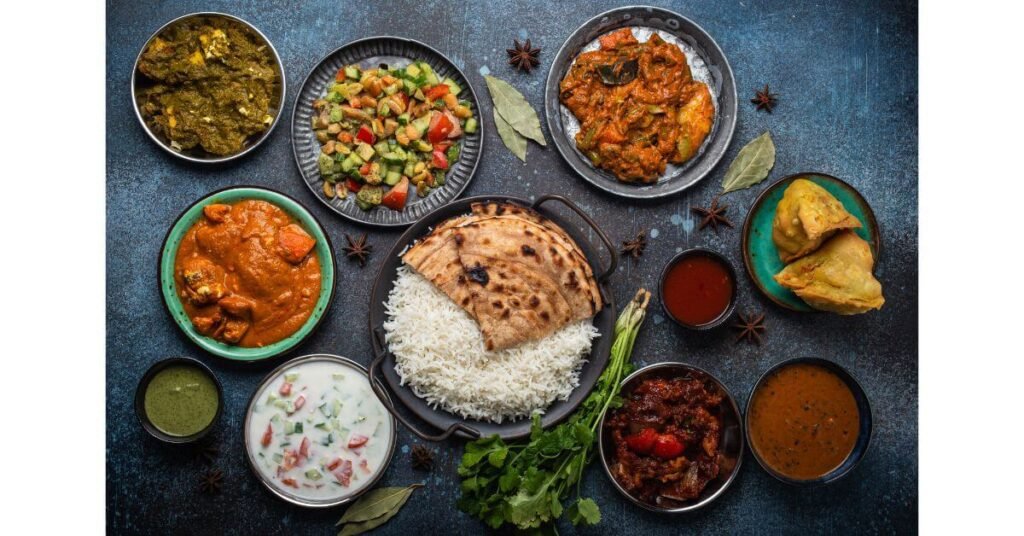
The preparation remains a sacred ritual, with khansamas (master chefs) beginning their work at dusk, carefully monitoring the slow-cooking process that results in the signature velvety texture and rich flavor that draws crowds before dawn.
Each bowl served represents not just a meal, but a taste of living history, particularly cherished during weddings, Eid celebrations, and crisp winter mornings when families gather to share this royal breakfast tradition.
Famous Street Food in Pakistan
Pakistan’s bustling streets come alive with an irresistible array of street food that captures the essence of local flavors and culinary traditions. From the winding alleys of Lahore’s Anarkali Bazaar to the vibrant Burns Road in Karachi, every corner tells a different food story through sizzling grills, steaming cauldrons, and aromatic food carts.
These street food havens offer an authentic taste of Pakistan’s diverse culinary heritage, where ancient recipes meet modern innovations. Whether it’s the tangy chaats, crispy samosas, or piping hot paratha rolls, street food in Pakistan represents more than just quick meals – it’s a cultural experience that brings together people from all walks of life.
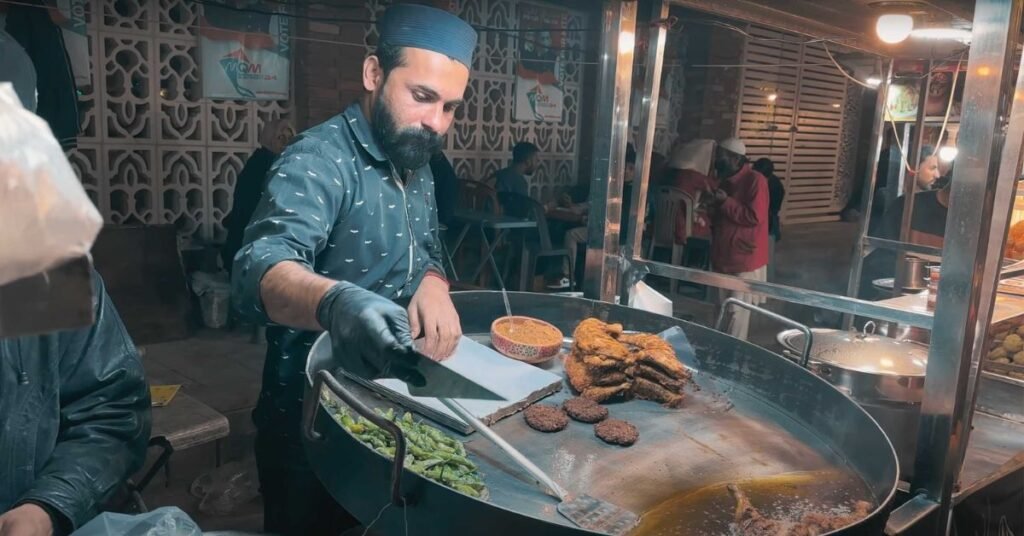
As we explore these culinary treasures, you’ll discover why Pakistan’s street food scene has become legendary among food enthusiasts worldwide.
Popular Pakistani Street Food Varieties
Gol Gappay and Chaat Delicacies
The realm of Pakistani street snacks reaches its pinnacle with gol gappay (also known as pani puri) and chaat – two iconic delicacies that perfectly balance sweet, sour, and spicy flavors. Gol gappay, those crispy hollow spheres filled with spicy tamarind water, chickpeas, and potatoes, create a burst of flavors that dance on your taste buds with each bite. Street vendors carefully guard their special recipes for the spicy water (meetha pani and teekha pani), often using secret combinations of mint, tamarind, and masalas passed down through generations.
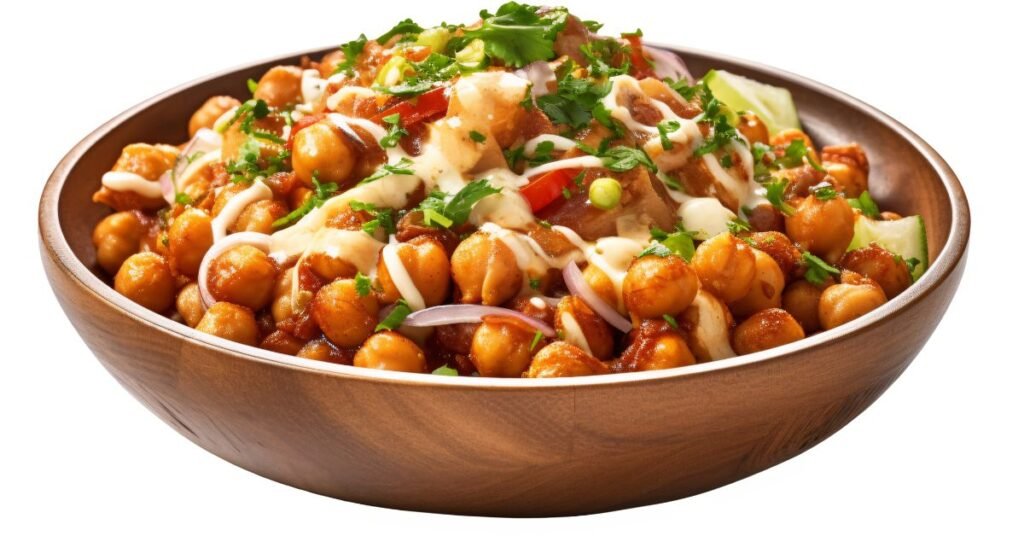
Meanwhile, chaat varieties like papri chaat, dahi bhalla, and aloo chaat showcase the artful combination of crispy crackers, yogurt, sweet and tangy chutneys, and a sprinkle of chaat masala. In bustling locations like Lahore’s Liberty Market, Karachi’s Do Darya, and Islamabad’s Jinnah Super Market, skilled vendors create these snacks with theatrical flair, entertaining customers while assembling each serving with practiced precision.
These beloved street foods aren’t just snacks – they’re an integral part of Pakistan’s social fabric, bringing people together for a quick, flavorful bite any time of day.
Traditional Desserts and Sweet Treats
Must-Try Pakistani Desserts
Zarda and Kheer Preparations
Zarda and Kheer represent the pinnacle of Pakistani rice-based desserts, each offering a unique take on sweet comfort food. Zarda, meaning ‘yellow sweet rice,’ gets its distinctive color from food coloring or saffron and is enriched with milk, sugar, and aromatic cardamom.
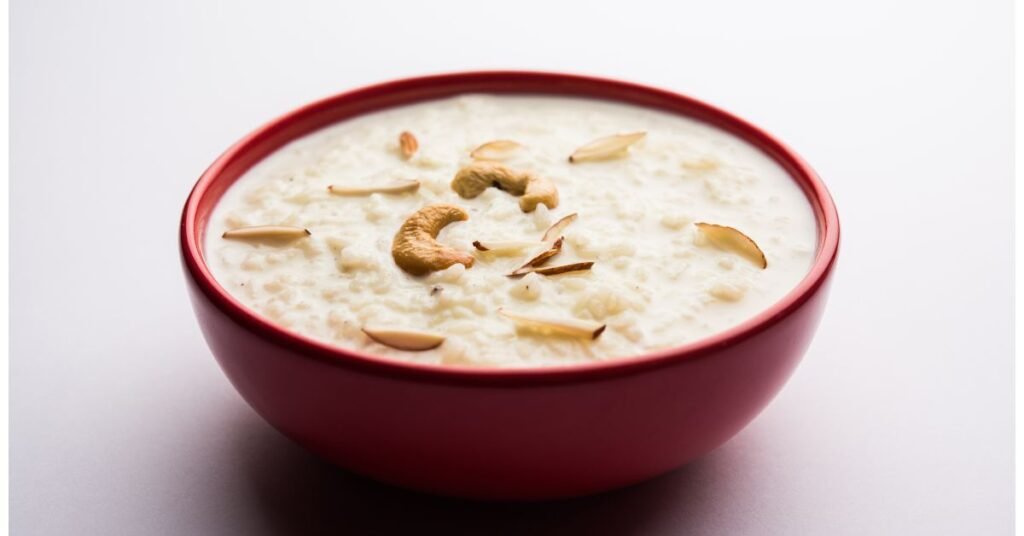
The preparation involves cooking rice with milk and sugar until tender, then garnishing it with nuts, dried fruits, and colorful candied sweets (murabba). Kheer, on the other hand, transforms rice into a creamy pudding through slow cooking in milk, flavored with cardamom, cinnamon, and sometimes rosewater.
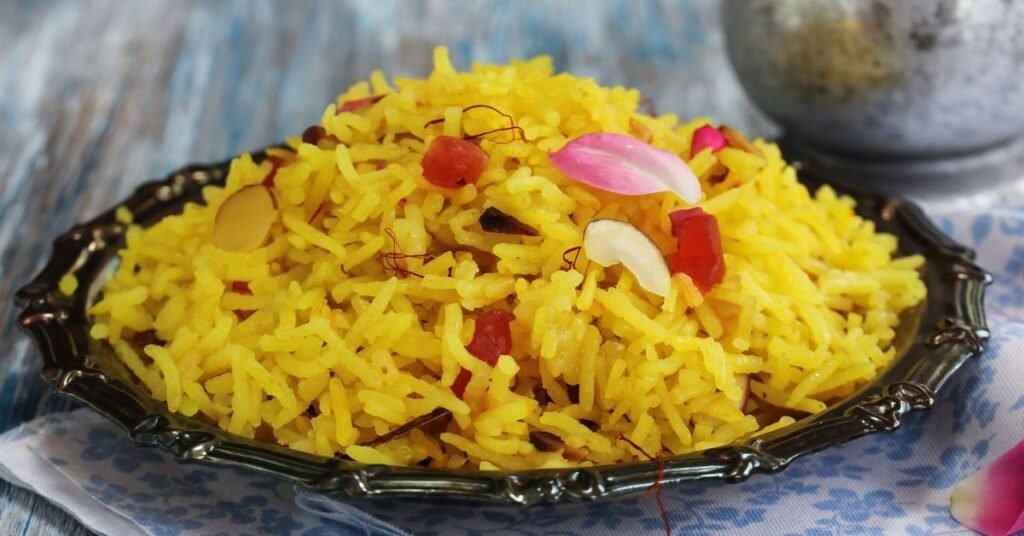
The dish achieves its signature silky texture through patient stirring and reducing, while garnishes of pistachios, almonds, and a touch of silver varq (edible silver leaf) add both visual appeal and textural contrast.
Regional Sweet Specialties
Each region of Pakistan boasts its own beloved sweet specialties, creating a diverse landscape of dessert traditions. In Punjab, the famous Multani sohan halwa, a dense, ghee-based confection studded with nuts, showcases the region’s love for rich, intense flavors. Peshawar is renowned for its lab-e-shireen, a mixture of various dried fruits and nuts served during special occasions.
Southern Pakistan, particularly Sindh, contributes the unique lab-e-mashook, a milk-based sweet flavored with cardamom and topped with dried fruit. In Balochistan, you’ll find the unique date-based sweets that reflect the region’s abundant date palm cultivation.
These regional specialties not only satisfy sweet cravings but also tell stories of local ingredients, cooking techniques, and cultural celebrations unique to each area.
Health and Nutrition in Pakistani Cuisine
While Pakistani cuisine is often celebrated for its rich flavors and aromatic spices, it also carries significant nutritional benefits rooted in ancient culinary wisdom. Traditional cooking methods and ingredients have been carefully selected over generations to create not just delicious meals, but also nutritionally balanced dishes.
From the protein-rich lentil preparations to the probiotic-packed lassi drinks, Pakistani cuisine offers a diverse range of nutrients through its varied cooking techniques and wholesome ingredients. Many dishes incorporate healing spices like turmeric, cumin, and coriander, which are known for their anti-inflammatory and digestive properties, while the generous use of garlic, ginger, and fresh herbs adds both flavor and medicinal benefits to daily meals.
Nutritional Value of Pakistani Foods
The nutritional profile of Pakistani foods is remarkably diverse and comprehensive. Staple dishes often combine multiple food groups – proteins from meat and legumes, complex carbohydrates from rice and rotis, and essential vitamins and minerals from fresh vegetables and herbs. For instance, a typical Pakistani thali (platter) includes dal (lentils) rich in plant-based protein and fiber, salad providing vital vitamins and minerals, and yogurt offering calcium and probiotics.
The use of grass-fed meat in traditional dishes provides high-quality protein and essential fatty acids, while the incorporation of whole spices adds antioxidants and aids digestion. Even Pakistani desserts often include nutrient-rich ingredients like nuts, milk, and natural sweeteners, contributing to their nutritional value despite their indulgent nature.
Summary
Pakistan Famous Food represents a vibrant tapestry of flavors, traditions, and culinary excellence that spans centuries of cultural heritage. From the aromatic biryani that reigns as the national favorite to the hearty nihari that carries royal legacy, Pakistani cuisine offers an extraordinary range of dishes that captivate food enthusiasts worldwide. The street food scene, particularly in bustling cities, showcases beloved snacks like gol gappay and chaats, while traditional desserts like zarda and kheer add a sweet finale to any meal.
Each region contributes its unique flavors and cooking techniques, whether it’s Karachi’s spicy biryani, Peshawar’s minimalist karahi, or Lahore’s rich nihari. Beyond their delectable taste, Pakistan Famous Food also carries significant nutritional value, incorporating healthy ingredients and traditional cooking methods that have been perfected over generations. This culinary journey through Pakistan reveals not just a cuisine, but a celebration of history, culture, and community that continues to evolve while maintaining its authentic roots.


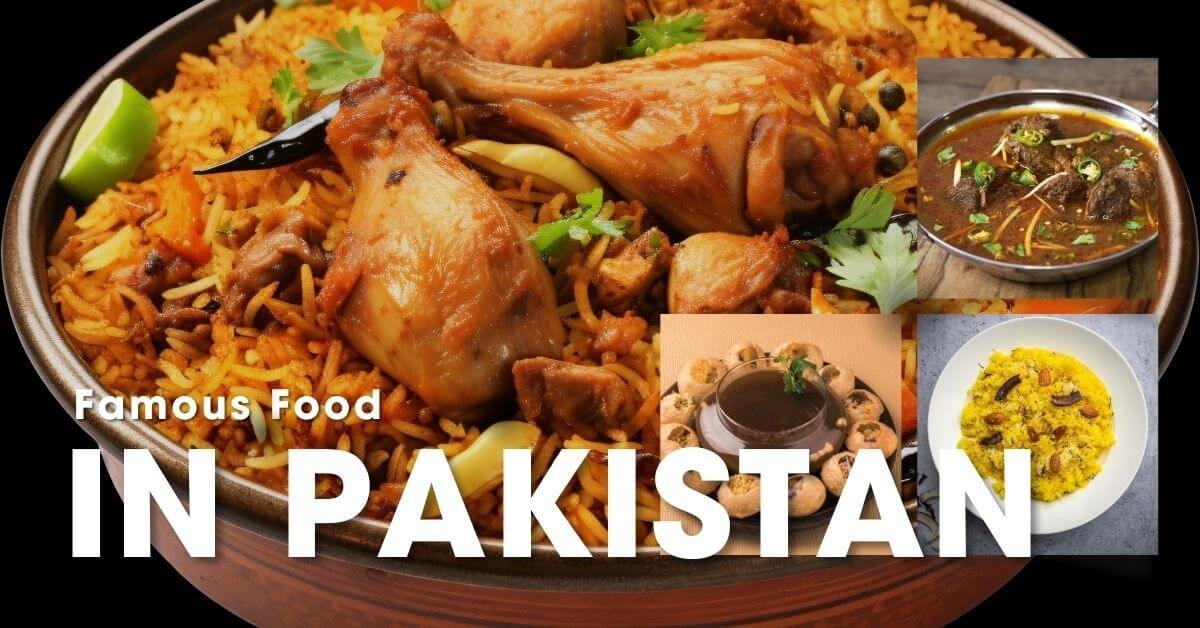
0 Comment